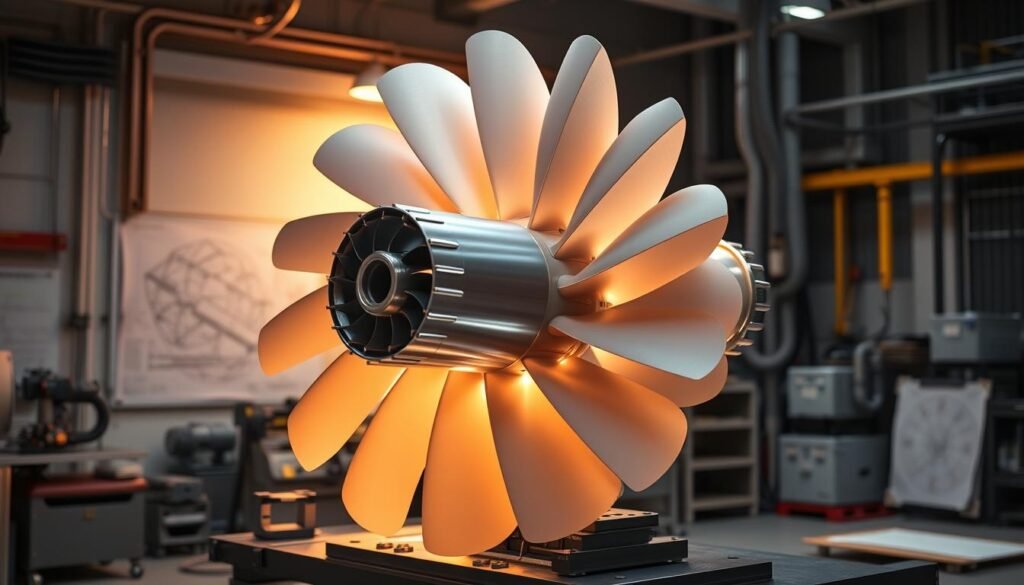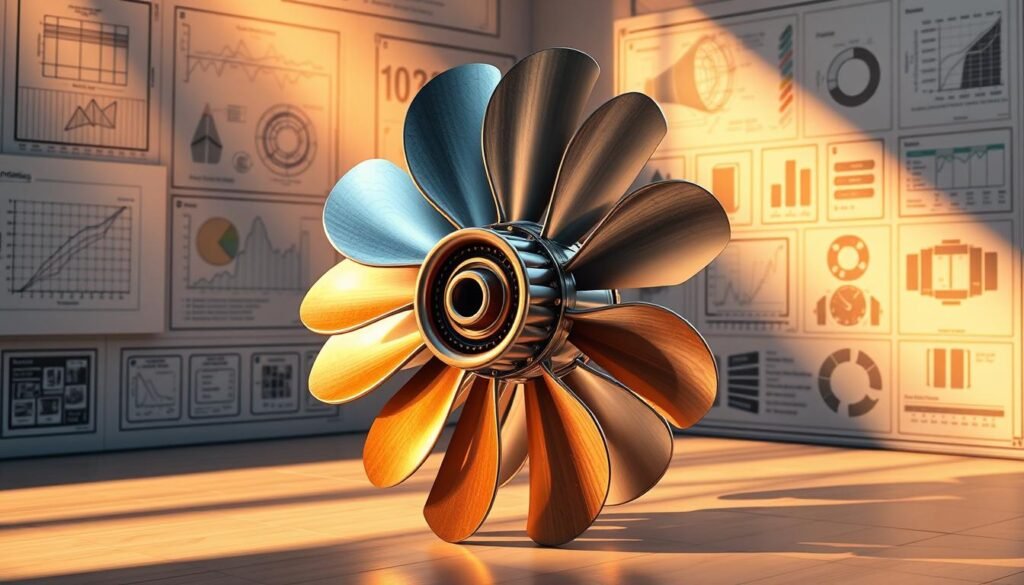The aerospace field is always changing. It needs more efficient and lighter aircraft parts. Aerospace engineering plays a big role here. Impellers are key to aircraft performance and efficiency, and the right materials are crucial.
Manufacturers must think about how these materials affect the aircraft’s performance. This is important for design optimization.
As the industry moves forward, finding new design solutions is key. Advanced materials for impellers are essential. They help make lighter, more efficient parts that boost aircraft performance.
Design optimization techniques help create top-quality impellers. This is vital in aerospace engineering.
In this article, we’ll explore lightweight impeller design. We’ll look at the challenges and solutions in aerospace engineering. We’ll also discuss the role of impeller materials in design optimization.
We’ll cover the latest in manufacturing and aerodynamics. This will give insights into the future of aerospace impeller technology. And why design optimization is so important in this field.
Understanding the Critical Role of Lightweight Impeller Design in Aerospace Applications
Lightweight impeller design is key to top aerodynamic performance in space. The shape, size, and material of the design greatly affect an aircraft’s performance. It’s also crucial to follow industry standards and meet safety and reliability rules.
The design parameters of a lightweight impeller are very important. They determine how well the impeller works. Key factors include:
- 재료 선택: Choosing materials that are both light and strong
- Shape and size: Making the impeller as light as possible while keeping it effective
- Aerodynamic characteristics: Designing the impeller for the best aerodynamic performance
Following industry standards is vital for safety and reliability in aerospace. Bodies like the Federal Aviation Administration (FAA) have strict rules. By following these, makers can make sure their impellers are up to par. This leads to better aerodynamic performance and more efficiency.
Common Challenges in Aerospace Impeller Development
Aerospace impeller development faces many challenges. One key issue is finding materials that can handle harsh flight conditions without being too heavy. 재료 선택 is crucial because it affects how well the impeller works and its efficiency. Advanced manufacturing techniques also play a big role in the quality and reliability of the final product.
Another big challenge is design optimization. This involves balancing factors like aerodynamics, strength, and how easy it is to make the impeller. To overcome these hurdles, developers use the latest technologies and thorough testing. Important things to consider include:
- Material properties and compatibility
- Design complexity and manufacturability
- Performance requirements and optimization strategies
By tackling these challenges, developers can make aerospace impellers that perform well under tough conditions. 
Advanced Materials and Manufacturing Techniques for Lightweight Impellers
Creating lightweight impellers depends on advanced materials and manufacturing. Using composites and smart materials helps reduce weight without losing strength. These materials are key to balancing weight and performance.
New manufacturing methods like 3D printing and CNC machining make complex shapes possible. These techniques improve design flexibility and quality control. Ensuring the reliability and safety of these impellers requires strict testing and inspection.
Innovative Material Selection Strategies
- Composites: Offer high strength-to-weight ratio and resistance to fatigue
- Smart materials: Can adapt to changing environmental conditions
- Hybrid materials: Combine different materials to achieve optimal performance
Cutting-edge Manufacturing Processes
These include 3D printing, CNC machining, and other advanced techniques. They allow for complex shapes and precise parts. Using these methods improves quality and cuts down production time.
| Manufacturing Process | Benefits |
|---|---|
| 3D printing | Increased design flexibility, reduced material waste |
| CNC machining | Improved precision, faster production time |
Optimization Strategies in Lightweight Impeller Design
Design optimization is key in making lightweight impellers better. It affects how well they work and how strong they are. Engineers use tools like computational fluid dynamics (CFD) and finite element analysis (FEA) to test different designs. This helps find the best solutions.
Some important strategies include:
- Parametric studies to see how design changes affect performance
- Shape optimization to make impellers lighter without losing strength
- Multi-disciplinary optimization to balance performance and weight
These methods help designers make impellers that do more than expected. They also make sure the impellers are strong. Effective design optimization is essential for finding the right balance between performance and weight. This leads to better efficiency overall.

By taking a comprehensive approach to design optimization, engineers can explore new possibilities in lightweight impeller design. This drives innovation and progress in the aerospace field. As the industry keeps growing, design optimization will become even more crucial. It will play a big role in shaping the future of flight.
Performance Analysis and Testing Methodologies
Performance analysis and testing are key steps in making lightweight impellers. To get the best results, makers use CFD analysis, physical testing, and performance checks. These steps help spot problems, improve design, and confirm how well the part works.
CFD analysis is a computer method for simulating how the impeller moves air. It lets engineers study fluid and gas flow, finding ways to make it better. 하지만, physical testing is needed to check if the CFD results are right and if the part meets standards.
Key Performance Indicators
- Efficiency and performance metrics
- Structural integrity and durability
- Aerodynamic characteristics and flow behavior
By mixing CFD analysis, physical testing, and performance checks, makers can make sure their lightweight impellers work well. 이런 식으로, they create parts that are efficient, reliable, and up to the aerospace industry’s standards.
결론: Future Trends and Opportunities in Aerospace Impeller Technology
The aerospace industry is growing, and so is the need for lighter, more efficient impellers. Companies are ready to take advantage of the future trends 그리고 opportunities in the aerospace industry. New materials and advanced manufacturing methods will lead to better impellers.
These advancements will make impellers stronger and more efficient. They will also help reduce waste during production. This is thanks to new materials and ways of making things.
Computational fluid dynamics (CFD) and advanced simulations will play a big role in the future. They will help make impellers even better. Smart sensors and predictive maintenance will also change how we look after impellers.
This will make sure they work well and safely. It’s a big step forward for the aerospace industry.
With these future trends 그리고 opportunities, companies can lead the way in the aerospace industry. They will create innovative solutions that move the industry forward.
